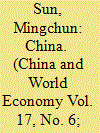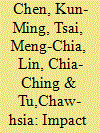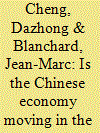|
|
|
Sort Order |
|
|
|
Items / Page
|
|
|
|
|
|
|
| Srl | Item |
| 1 |
ID:
092426


|
|
|
|
|
| Publication |
2009.
|
| Summary/Abstract |
This paper investigates the reasons behind the resilience of China's economy to the global financial tsunami. China's economy is lowly leveraged in its banking, household, public and external sectors and, therefore, is less plagued by the global deleveraging than most developed economies. Chinese domestic sectors have improved significantly over the past decade, giving them larger capacity to cope with external shocks than during the Asian financial crisis a decade ago. Contrary to the conventional wisdom that China's economic growth is highly dependent on exports, we find that the main growth engine for China is domestic demand. Destocking, rather than falling exports, was the main cause of the sharp economic slowdown in China in late 2008 and early 2009. Therefore, the global economic slowdown should have limited impact on China's economy. We forecast a sustained economic recovery in China in 2009-2011, with real GDP growth exceeding 10 percent in 2010.
|
|
|
|
|
|
|
|
|
|
|
|
|
|
|
|
| 2 |
ID:
083949


|
|
|
|
|
| Publication |
2008.
|
| Summary/Abstract |
Since 2003, the Chinese Government has been using land policy as an important macroeconomic policy. The present paper analyzes the impact of the expansion of construction land on economic growth in terms of the capital-output ratio. Using provincial panel data for China from 1999 to 2005, we conclude that the excess expansion of China's construction land led to an increase in the capital-output ratio. Therefore, expanding construction land has made little contribution to economic growth. This paper argues that contractionary land policy does not deter high economic growth, and is a necessary condition for a sustainable economic growth.
|
|
|
|
|
|
|
|
|
|
|
|
|
|
|
|
| 3 |
ID:
083954


|
|
|
|
|
| Publication |
2008.
|
| Summary/Abstract |
The dramatic movements of China's stock market in the past two and a half years have renewed debate among academics over the efficiency of China's stock market. The present paper tests the efficiency of China's stock market. The realization of efficient markets requires the effective operation of a complete set of macro and micro mechanisms. However, such mechanisms are not only incomplete in China's stock market, but are also ineffective because of the prevalence of institutional deficiencies.
|
|
|
|
|
|
|
|
|
|
|
|
|
|
|
|
| 4 |
ID:
083955


|
|
|
|
|
| Publication |
2008.
|
| Summary/Abstract |
The strong economic growth in China is difficult to reconcile with its inefficient financial system. The puzzle of China's financial development and growth can be explained through a dynamic criterion of adaptive efficiency, rather than through allocative efficiency. Using the framework of an autoregressive distributed lag model, the present paper tests the hypothesis that the GDP growth rate is dependent on financial development along with other variables in China and Pakistan. The hypothesis cannot be rejected in both cases. However, the results show that economic growth has a negative relationship with credit to the private sector in China. We conclude that financial development is a source of China's high growth rate and that the banking system is still under an evolutionary process, involving the pursuit of social objectives instead of the sole objective of profit maximization. Our results provide some implications for other developing countries like Pakistan.
|
|
|
|
|
|
|
|
|
|
|
|
|
|
|
|
| 5 |
ID:
092431


|
|
|
|
|
| Publication |
2009.
|
| Summary/Abstract |
This paper applies a computable general equilibrium model to investigate the potential economic effects of trade liberalization across the Taiwan Strait. Our simulation results reveal that cross-Strait trade liberalization will have significant positive impacts on external trade, domestic investment and real GDP for the economies in this area in general and in Taiwan in particular. Furthermore, the negative impact from the formation of a free trade arrangement between Taiwan and Chinese Mainland on Hong Kong seems to be rather small. These results suggest that cross-Strait trade liberalization is very likely to bring about a win-win situation for the economies in this area.
|
|
|
|
|
|
|
|
|
|
|
|
|
|
|
|
| 6 |
ID:
092424


|
|
|
|
|
| Publication |
2009.
|
| Summary/Abstract |
This paper applies a structural vector autoregression analysis to quantify the impact of the global financial crisis on China. It is found that the impact is indeed sizeable: a 1-percent decline in economic growth in the USA, the EU and Japan is likely to lead to a 0.73-percent decline in growth in China. The article discusses whether the current measures of fiscal stimulus are adequate to offset the sharp decline in external demand. Although there is little doubt that the massive fiscal stimulus will largely offset the significant shortfalls in external demand, the current growth pattern in China will be increasingly unsustainable in the long term. China's reform cycles suggest that external shocks are often opportunities for structural reforms. Therefore, the crisis could also be a catalyst for rebalancing China's economic structure so as to return the economy to a sustainable path.
|
|
|
|
|
|
|
|
|
|
|
|
|
|
|
|
| 7 |
ID:
083948


|
|
|
|
|
| Publication |
2008.
|
| Summary/Abstract |
Based on sample survey data for the years 2006 and 2007, we find that inflation of food and energy prices in China is moving at a slower pace than in the international market; however, the livelihood of low income groups has been significantly impacted. Urban sample households in low income groups have been shifting from consumption of high value food to lower value substitutes; and all of the rural sample households are reducing their total consumption expenditure in real terms. The Engel's coefficient of the rural household enlarged while their proportion of spending on clothing and energy declined. Farmers' households are moving toward more imbalanced diets, and the nutritional status of the poor is apparently deteriorating. The emergency-response measures that the government should implement include stopping subsidies to biofuel producers, who use foodstuffs as inputs, and providing food aid to the poor. The mid-term strategies should include anti-monopoly tactics, improving the market environment for the right competition, and eliminating price distortion. Midterm and long-term socioeconomic policy reform must be undertaken to adjust the social structure, to correct the mechanism of factor price formation, and to transform the pattern of economic growth.
|
|
|
|
|
|
|
|
|
|
|
|
|
|
|
|
| 8 |
ID:
092430


|
|
|
|
|
| Publication |
2009.
|
| Summary/Abstract |
Drawing upon output, employment, consumption and trade data, this article examines whether there is an economic tertiarization trend in China 's economy and evaluates the common factors driving current trends. It shows that the tertiarization trend is evident for the overall economy and most regions in terms of the service nominal value-added ratio and service employment and consumption. However, the tertiarization trend is not significant in terms of the service real value-added ratio, and there is even some concurrent "detertiarization" because of the decreasing proportion of services in imports and exports. Indeed, China's tertiarization trend is far behind its industrialization trend. The rise in the relative prices of services explains the rising proportion of household service consumption expenditure and further illuminates why the service real value-added ratio has not grown. The main cause for the growing percentage of service employment is the lag in service labor productivity growth in interaction with the price inelasticity of service demand. "Cost disease" has appeared in service consumption.
|
|
|
|
|
|
|
|
|
|
|
|
|
|
|
|
| 9 |
ID:
083952


|
|
|
|
|
| Publication |
2008.
|
| Summary/Abstract |
The year 1996 was a turning point both in terms of Chinese labor market reform and in China's economic growth pattern. Before 1996, labor market reform was mainly implemented through adjustment of people's occupation and income structure. Since 1996, employment restructuring has led to differentiation in terms of employment status. Labor market reform in the former stage resulted in slow growth in wages, whereas reform in the latter stage enhanced economic efficiency. Both stages have enabled the Chinese economy to apply its comparative advantage of low labor cost. Labor market reform has also increased income disparity and, therefore, new challenges are posed in sustaining economic growth. China needs to adjust its development strategies and introduce labor market reform that can improve income equality, so as to achieve sustainable economic development.
|
|
|
|
|
|
|
|
|
|
|
|
|
|
|
|
| 10 |
ID:
092427


|
|
|
|
|
| Publication |
2009.
|
| Summary/Abstract |
The Chinese life-insurance industry has experienced major structural changes in recent years, primarily because of increasing demand and the entry of foreign insurers. Although the market is clearly booming, the efficiency of its growth and development is unclear. In this paper, we evaluate the efficiency of life insurers operating in China and compare foreign firms with domestic firms. We find that foreign insurers have not brought efficiency into the Chinese market, and that the market is still dominated by domestic giants. However, the gap between foreign insurers and domestic insurers is narrowing. After testing hypotheses regarding scale economy, technical progress and potential improvements, we discuss several issues of importance to life insurers, market investors and government regulators.
|
|
|
|
|
|
|
|
|
|
|
|
|
|
|
|
| 11 |
ID:
083956


|
|
|
|
|
| Publication |
2008.
|
| Summary/Abstract |
The present paper analyzes the potential impacts of bio-ethanol expansion on agricultural production, food prices and farmers' incomes in different regions of China. The results show that increase in demand for feedstock to produce bio-ethanol will lead to large increase in the prices of agricultural products. The increase in prices will trigger a significant rise in the production of feedstock at the cost of lower rice and wheat production. The study also reveals that the impacts of bio-ethanol on farmers' incomes vary largely among regions and farmer groups. Given the expected expansion of bio-ethanol production in the future, and the limited land resources for feedstock production in China, the viability of different crops as feedstock for bio-ethanol requires careful analysis before a large-scale expansion of China's bio-ethanol program. Bio-ethanol production in China should be relying more on the second generation of bio-ethanol technologies (i.e. using celluloses to produce bio-ethanol), and China's government should increase research investment in this field.
|
|
|
|
|
|
|
|
|
|
|
|
|
|
|
|
| 12 |
ID:
092428


|
|
|
|
|
| Publication |
2009.
|
| Summary/Abstract |
Using 1987-2006 panel data for China, we explore the dynamics of the skill premium. The present paper focuses on the skill premium as an explanation for why income differences are so large in China. Our empirics show that: the rise in the relative supply of skilled labor results in an increase, instead of a decrease, in the skill premium; domestic investment is not complementary with skill formation; the skillpremium is higher in more developed provinces; economic openness facilitates an increase in the skill premium; whether foreign direct investment induces skill-based technology change or not, it drives up the skillpremium. An array of policy prescriptions for reducing income differences and ensuring sustained economic growth are provided.
|
|
|
|
|
|
|
|
|
|
|
|
|
|
|
|
| 13 |
ID:
083950


|
|
|
|
|
| Publication |
2008.
|
| Summary/Abstract |
In the present paper, we model the policy stance of the People's Bank of China (PBC) as a latent variable, and the discrete changes in the reserve requirement ratio, policy interest rates, and the scale of open market operations are taken as signals of movement of this latent variable. We run a discrete choice regression that relates these observed indicators of policy stance to major trends of macroeconomic and financial developments, which are represented by common factors extracted from a large number of variables. The predicted value of the estimated model can then be interpreted as the implicit policy stance of the PBC. In a second step, we estimate how much of the variation in the PBC's implicit stance can be explained by measures of its policy objectives on inflation, growth and financial stability. We find that deviations of CPI inflation from an implicit target and deviations of broad money growth from the announced targets, but not output gaps, figure significantly in the PBC's policy changes.
|
|
|
|
|
|
|
|
|
|
|
|
|
|
|
|
|
|
|
|
|